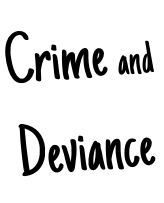|
|
|
|
This introduction to crime and deviance examines definitions of crime and deviance, different types of deviance (including societal and situational, culpable and non- |
|
|
Is Crime a Cause of Crime? This set of Notes shows at how students can methodologically evaluate Felson and Cohen’s Routine Activities approach (1979) to understanding crime and crime prevention. Is one of the most- |
|
|
Broken Windows: Revisited |
This 3- 1. Broken Windows: The general theoretical and empirical background - 2. Broken Windows: The ecological context locates the general theory in its historical context and critically examines Zimbardo's "Anonymity of Place" experiment - 3. Do small disorders lead to major disorders? The final part looks at recent (2017) research that questions the claim proactive / Zero Tolerance policing prevents minor forms of social disorder developing into major forms. |
|
Situational Acton Theory |
Although Situational Action Theory is one of the more- 1. Situational Action Theory provides a theoretical overview and shows how it can be broadly applied to explain crime and deviance. 2. Crime and Social Disadvantage looks more- 3. Crime and Social Disadvantage: The Evidence applies Situational Action Theory to Wikstrom's Peterborough Adolescent and Young Adult Development Study (PADS) to show how the relationship between crime and inequality theorised by Situational Action Theory can be empirically demonstrated. |
|
Explanations for Crime and Criminality |
All your favourite explanations for crime conveniently grouped into a range of sociological perspectives for your revision pleasure: |
|
Nutshell Studies |
The idea behind Nutshell Studies is to make it easier for students to get to grips with significant classic and contemporary sociological studies in a simple, straightforward, way that doesn’t involve a shed- 1. Alexander “The New Jim Crow: Mass Incarceration in the Age of Colorblindness” (2010) 2. Merton: Strain Theory (1938) |
|
Designed, in the author David Keir's words, to be "a very gentle introduction" to the AQA Deviance and Social Control synoptic module. The focus of this illustrated booklet is on identifying, defining and explaining a range of introductory concepts relating to deviance (Defining deviance; Types (formal and informal); Social control (formal and informal); Conflict and consensus policing; Social sanctions. The format combines informative notes with brief exercises and extensive synoptic links. |
|
|
A general overview of explanations for the social distribution of crime that includes patterns of crime according to region, age, gender and class as evidenced through Official statistics and British Crime Surveys. |
|
|
The focus here is sociological criticisms of non- |
|
|
An overview of the general Functionalist perspective with an emphasis on Durkheim and the functions of crime and Merton's Strain Theory. |
|
|
An introduction to Interactionist ideas about crime and deviance, including the "I" and the "Me"; Delinquency and Drift and Labelling theory. |
|
|
An outline of Marxist conflict theory as a distinct sociological perspective. This looks at how "Orthodox" or "Traditional" Marxism has examined the nature of crime and deviance through concepts of power and ideological controls. |
|
|
An exploration of Taylor, Walton and Young's principles of a "fully social theory of deviance" that includes: The relationship between the social structure of Capitalist society and crime; Radical criticisms of Functionalist and Interactionist theories of deviance; Examples of Radical Criminological studies. |
|
|
An overview of the theoretical origins of Radical Criminology as they can be related to Instrumental forms of Marxist analysis. |
|
|
An outline of how Radical Criminology's "fully social theory of deviance" can be applied to understand some forms of sex crime. This file is based on an article by Soothill and Grover. |
|
|
An overview and evaluation of Right Realism, including Control theory and Situational theory. |
|
|
This brief examination of the theoretical background to situational crime prevention looks at: 1. The broad background in terms of a general “environmental discourse” that encompasses both cultural and physical environments. 2. A couple of New Right approaches – Control Theory and Routine Activities Theory – that flow from this general discourse. |
|
|
An overview of Left Realism and its criticism of conventional and radical forms of criminology; the relative validity of official crime statistics; the relationship between concepts of subculture, relative deprivation and political marginalisation. |
|
|
Focused on the idea of offender and victim profiling, this introduces both the 3- |
|
|
|
Introduction to some of the key ideas that characterise Left Realist approaches to understanding crime and criminality: key concepts, types of crime, the problem of crime, solutions to crime, how to research crime. Includes a number of short criticisms of the perspective, including a couple you might not have come across before. |
|
This overview of Functionalist subcultural theories examines examples of Reactive and Independent subcultures. |
|
|
Youth Culture |
This complete chapter, taken from OCR Sociology for AS (2012), examines the concept of youth and youth culture across four main areas: |
|
Exploring the concept of "youth" and outlining early theories of youth deviance. |
|
|
Examining three broad perspectives on youth subcultures: Functionalist, Marxist, Interactionist perspectives and beyond. Also looks at semiological analyses of youth subcultures. |
|
|
Examines the difference between culture and subculture and explores theories of youth cultures and subcultures, including concepts of hegemony; relative autonomy and semiology. |
|
|
Overview of Durkheim's explanation of suicide (including methodological outline), plus some general positivist explanations for suicide. |
|
|
Interactionist and positivist critiques of Durkheim plus Interactionist explanations of suicide. |
|
|
An updated and more- 1. The Sociological Study of Suicide. 2. Suicide Typologies. 3. Positivist Approaches and studies. 4. Interpretivist Approaches and studies. 5. Realist Approaches and studies. |
|
|
This complete book chapter covers 5 areas: 1. Different explanations of crime, deviance, social order and social control. 2. The social construction of and social reactions to crime and deviance, including the role of the mass media. 3. The relationship between deviance, power and social control. 4. Different explanations of the social distribution of crime and deviance by age, social class, ethnicity, gender and locality. 5. The sociological issues arising from the study of suicide. |
|
|
Set of revision notes covering various aspects of UK victimisation policy: from victim representation through the victim's code to victim compensation. |
|
|
A teachers and learners support pack I wrote at some point for ATSS. In broad terms it contains background notes on Interactionist sociology and how it relates to the amplification process. The document also contains a range of relatively simple activities related to deviancy amplification, including a short self- |
|
|
This general introduction to classical ecological theories outlines and evaluates Concentric Zones; Cultural Transmission and Differential Association. |
|


